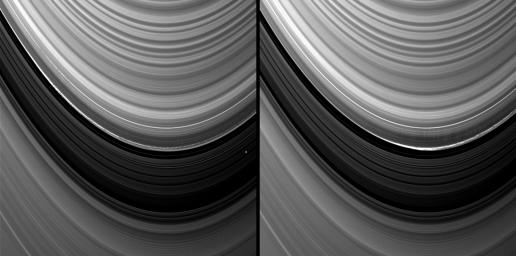Vertical structures in the variable outer edge of Saturn's B ring cast shadows in these two images captured by NASA's Cassini spacecraft shortly after the planet's August 2009 northern vernal equinox.
In these two images, Cassini's narrow angle camera captured a 20,000-kilometer-long (12,000-mile-long) section arcing along the outer edge of the B ring in Saturn's rings. This particular section of the ring is known to be the site of vertical structures as tall as 3.5 kilometers (2.2 miles). See PIA11668 to learn more.
The B ring is shown at the top of both frames. The Cassini Division, a low-density ring region that separates the B ring from the A ring, runs from the bottom right to the upper left of the images. The A ring is at the bottom.
Cassini imaging scientists have concluded that this region and another in this vicinity are the sites of massive bodies, or moonlets, embedded near the ring's edge but independently orbiting Saturn. In the particular region shown in this image, the moonlets are likely big enough to cause ring material streaming past them to be excessively compressed and thrown vertically as a result.
This interpretation is supported by Cassini's previous discovery of a moonlet embedded in this region of the B ring (see PIA11665). The imaged moonlet, whose size is estimated at 300 meters (1,000 feet) across, was found only because it was betrayed by the shadow it cast during Saturn's August 2009 equinox period.
This image and others like it are only possible around the time of Saturn's equinox which occurs every half-Saturn-year (equivalent to about 15 Earth years). The illumination geometry that accompanies equinox lowers the sun's angle to the ring plane and causes structures jutting out of the plane to cast long shadows across the rings. Cassini's cameras have spotted not only the predictable shadows of some of Saturn's moons (see PIA11657), but also the shadows of newly revealed vertical structures in the rings themselves (see PIA11654).
Both panels were re-projected to the same viewing geometry. The right-hand panel is a mosaic of two images. The images of the right-hand panel were taken in visible light with the Cassini spacecraft narrow-angle camera on Aug. 19, 2009. Two stars are visible.
The left-hand panel was taken in visible light with the Cassini spacecraft narrow-angle camera on Aug. 16, 2009. One star is visible.
This view looks toward the northern, sunlit side of the rings from about 11 degrees above the ring plane at a distance of approximately 2.3 million kilometers (1.4 million miles) from Saturn. Image scale is 13 kilometers (8 miles) per pixel.
The Cassini-Huygens mission is a cooperative project of NASA, the European Space Agency and the Italian Space Agency. The Jet Propulsion Laboratory, a division of the California Institute of Technology in Pasadena, manages the mission for NASA's Science Mission Directorate, Washington, D.C. The Cassini orbiter and its two onboard cameras were designed, developed and assembled at JPL. The imaging operations center is based at the Space Science Institute in Boulder, Colo.
For more information about the Cassini-Huygens mission visit http://saturn.jpl.nasa.gov/. The Cassini imaging team homepage is at http://ciclops.org.

 Planetary Data System
Planetary Data System












